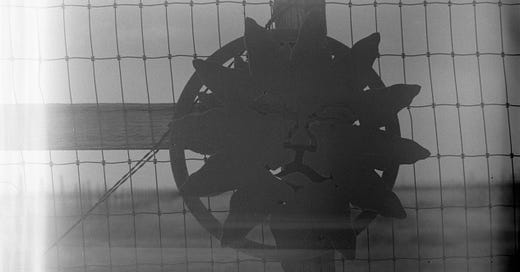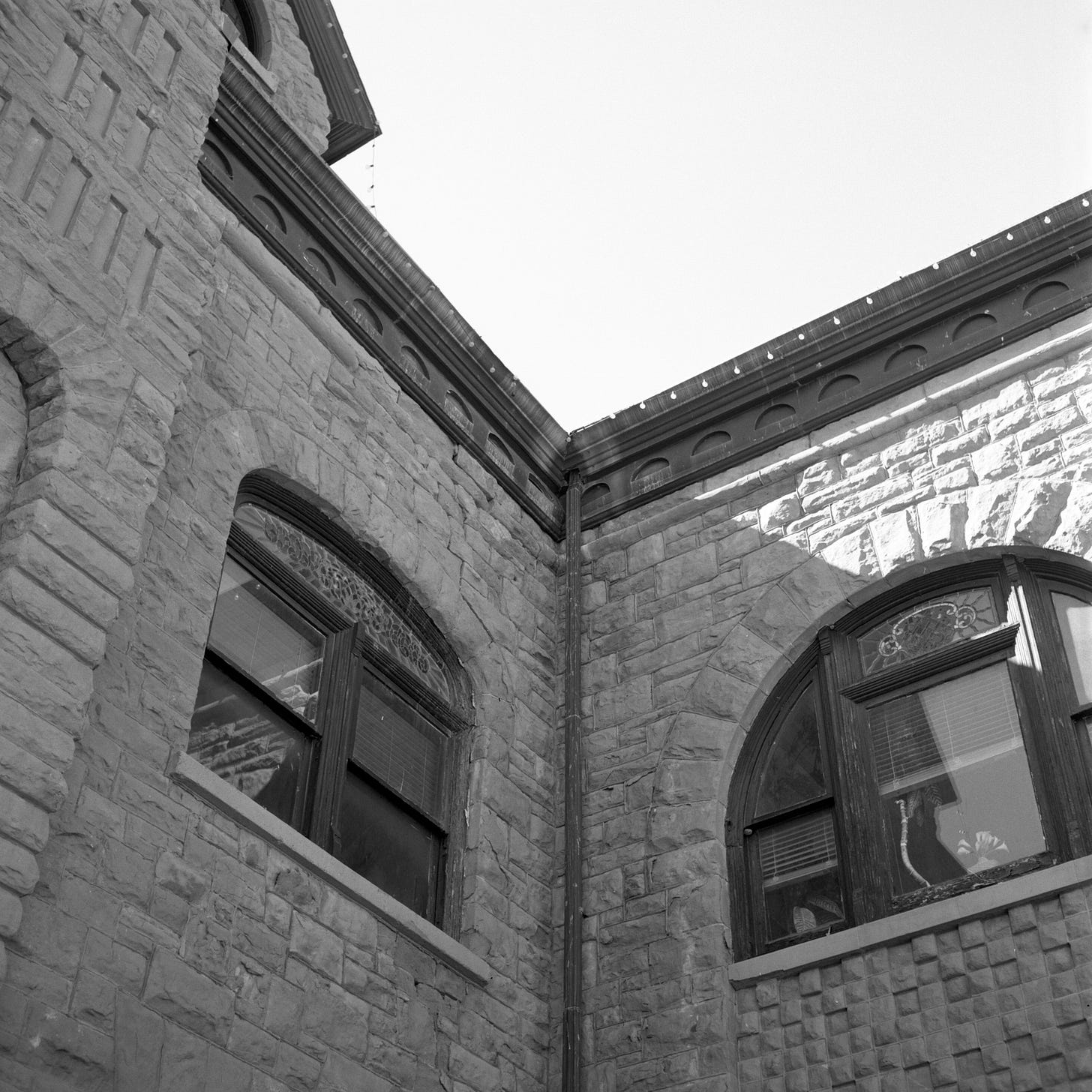I'd Like To Get Some Sleep Before I Travel
But if you gotta warrant, I guess you're gonna come in.
First, let me say that I haven’t had this much fun with photography in many years. That’s not to say that I haven’t enjoyed my job, or enjoyed shooting things on my digital cameras, but delving (back) into film is really making me look forward to shooting. So many ideas!
A couple of weeks ago, I started a quest to find, and purchase, some medium-format film cameras, in good condition, in preparation for a photography project. The first camera I was able to find was a Yashica MAT 124G. The second camera I was able to find, was a Bronica Model S. I got the shots from the first roll through that camera yesterday, too. They were not as good, let me show you.
What you see here is failure, do to operator error. The effect that you see is known as “Light Leakage”. Sometimes, that is cause by light sneaking in through loose fittings in the camera, this leakage comes from me being unfamiliar with the Bronica, and being a BIT too stupid before I opened the camera to get the film. Alas, there is no fixing stupid. On a side note, I have put my second roll through the Bronica, and I am feeling better about getting the film out of the camera, this time.
So…
Yesterday, I posted some shots from my first roll of film through the Yashica. I have been thinking about these shots all day, waiting to get back from work so that I could look through them with a bit more time. What I have come to understand is, my perspective on exposure has been greatly influenced by the digital world, so much so, that had I shot this first roll of film the way I do with my digital camera, the pictures would have been considered ruined.
Take this shot as an example.
I did not include this picture in the original posting, but let me tell you why I took it. The building is tall, and I was in the shadow of the building, The sun, was high and to the left of this picture. I held the light meter so that it faced the corner, to a reading and set the camera accordingly. I wanted to see the difference between the bright sky, the sunlit section at the top of the building, and the shadow.
Overall, I am very pleased with how this shot turned out, but I was NOT expecting it to be so clear. I was expecting it to be over-exposed to a much greater degree. Here, is where my digital conditioning showed through.
Digital photography is, essentially, an attempt to recreate chemical photography on a light-sensitive, digital sensor. Every year the digital camera makers are getting closer to being able to exactly replicate the analogue film process, but miss it by the smallest fraction. It is the very technology that allows for the digital picture to be taken that causes the gap.
The heart of the issue is, what do you do with the signal?
For the purposes of this discussion, “Signal” will refer to the energy that passes through the lens, to fall on the film/sensor. I first learned of this principle in the audio recording world, as it pertained to the sound passing through the microphone and how it was recorded. One method records sound, the other method records light, but the different mediums are governed by the same principles.
In both the analogue recording and photography world, settings can be adjusted so that the amount of energy (sound/light) that you expect to have, can be handled by your equipment. As long as the settings on your equipment are suitable for the energy you are experiencing, you will get a good result. However, if you get too much energy for the settings on your equipment (sound/light), you will, “Clip”. What this means in the analogue recording world is, your sound will become distorted and come across as fuzzy, which is bad. In film photography, too much energy for your settings will cause the brightest sections to seem too white, giving us the term, “Over Exposed”.
When you clip, in the analogue world, you still get a certain amount of information regarding your sound/light, but the quality is poor. In the digital world, though, clipping your settings gives you… nothing.
No sound, no light.
In the digital photography world, going beyond the settings means a complete loss of data. The loss of data can come when you have too much energy coming in (overexposed), as well as when you don’t have enough energy coming in (underexposed). The digital sensor in your camera can be adjusted, but there are upper and lower limits and your camera won’t be able to capture information on the light that is too high, or that is too low. With analogue recording/photography, there is still some information to be had above and below the line (distorted as it might be), but the digital world has nothing.
Which brings me back to this picture.
In this picture, my digital-influenced brain figured that the shy would be white (overexposed), which it is, but I also thought that the stonework that was in the sunshine would be overexposed to the point that you would not be able to see the texture of the stone. This is an example of the analogue process still being able to deliver some information, even if it is a bit too high for the settings. The stonework in the shadow, looks good, the stonework in the direct sun is not as good, but doable.
This brings up two rules-of-thumb for this shot, that seem contradictory at first, but are employed due to the way chemical photography is processed, as opposed to digital photography. In film photography the ROT is, expose for the shadows. With digital photography, you expose for the highlights.
With digital photography, you want your exposure to stay under the limit of the light coming through your lens. It’s much easier, in the digital world, to make your shadows lighter than to have your sensor lose information in a section of your shot that is too bright. Conversely, with film, it is easier to darken your brightest sections than to try and lighten your shadows. Remember, with the analogue process, there is still SOME information, even if it is poor quality.
I write all of this, not to bore you with details, but to tell you about a part of this renewed analogue journey that surprised me, because I did not realize how much my thought processes had changed due to the lack of familiarity with film photography. I now “see” photography through a digital filter. The digital perspective has become my default. It is going to be intriguing to see when and where I run into this situation again.






I am sorry to say that I am more of a point and shoot person. I had a 35mm camera in my younger days but never really figured out how to use it properly. Thank you for a lesson I never received.
I'm about to start testing my Kiev 6C medium format camera... as soon as I buy a take-up spool. :)
Would love to compare notes.